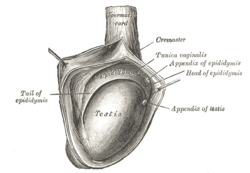Tunica vaginalis
| Tunica vaginalis | |
|---|---|
 Diagram of a cross-section of a testicle. 1. Cavity of tunica vaginalis, 2. Visceral lamina, 3. Parietal lamina. | |
 The right testis, exposed by laying open the tunica vaginalis. (Tunica vaginalis is labeled at upper right.) | |
| Details | |
| Latin | tunica vaginalis testis |
| Identifiers | |
| Gray's | p.1242 |
| Dorlands /Elsevier | t_22/12832403 |
| Anatomical terminology | |
The tunica vaginalis is the serous covering of the testis. It is a pouch of serous membrane, derived from the processus vaginalis of the peritoneum, which in the fetus preceded the descent of the testis from the abdomen into the scrotum.
After its descent, that portion of the pouch which extends from the abdominal inguinal ring to near the upper part of the gland becomes obliterated; the lower portion remains as a shut sac, which invests the surface of the testis, and is reflected on to the internal surface of the scrotum; hence it may be described as consisting of a visceral and a parietal lamina.
Visceral lamina
The visceral lamina (lamina visceralis) covers the greater part of the testis and epididymis, connecting the latter to the testis by means of a distinct fold. From the posterior border of the gland it is reflected on to the internal surface of the scrotum.
Parietal lamina
The parietal lamina (lamina parietalis) is far more extensive than the visceral, extending upward for some distance in front and on the medial side of the cord, and reaching below the testis. The inner surface of the tunica vaginalis is smooth, and covered by a layer of simple cuboidal mesothelial cells. The interval between the visceral and parietal laminæ constitutes the cavity of the tunica vaginalis.
Diseases
- Mesothelioma
- Hydrocele[1]
- Cartilaginous Bodies[2]
- Hematocele[3]
Additional images
-

Schematic drawing of a cross-section through the vaginal process.
References
This article incorporates text in the public domain from the 20th edition of Gray's Anatomy (1918)
External links
- Diagram at aspiruslibrary.org
- Anatomy photo:36:st-1502 at the SUNY Downstate Medical Center - "Inguinal Region, Scrotum and Testes: Tunic"
- Swiss embryology (from UL, UB, and UF) ugenital/diffmorpho04
- inguinalregion at The Anatomy Lesson by Wesley Norman (Georgetown University) (testes)
| ||||||||||||||||||||||||||||||||||||||||||||||||||||||